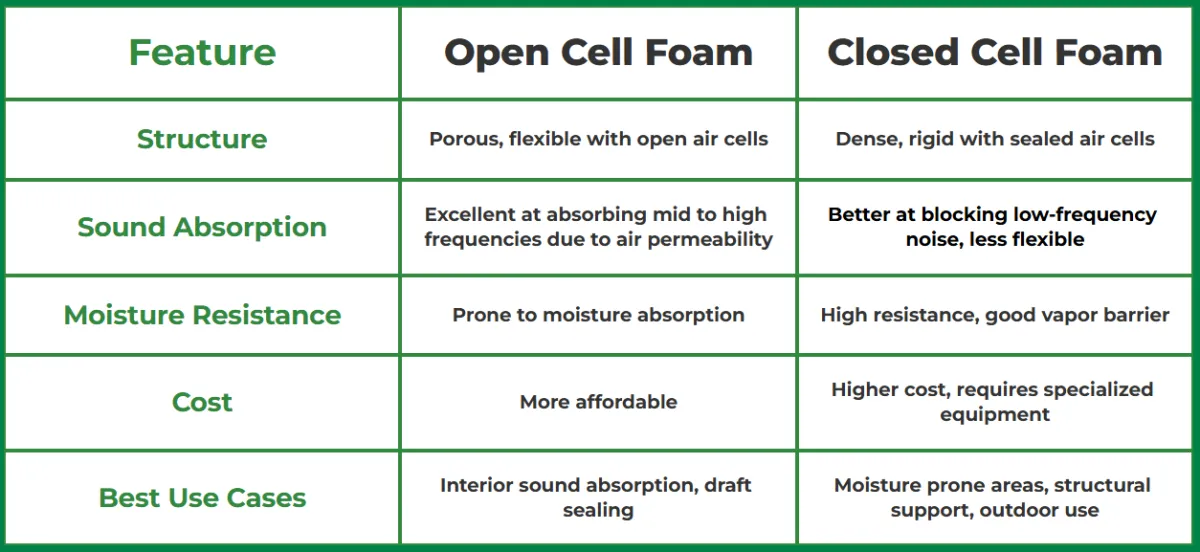Open Cell Foam For Soundproofing: Will It Work?
What Is Open Cell Foam?
Open cell foam is a popular type of spray foam insulation known for its porous, sponge-like structure. These open cells trap air, making the foam flexible and excellent for sealing gaps and cracks in walls, ceilings, and crawl spaces. Because of its structure, open cell foam also helps absorb sound waves, reducing echoes and noise reverberation inside a space.
How Does Open Cell Foam Work for Soundproofing?
Unlike solid materials that block sound by reflecting it, open cell foam absorbs sound by allowing sound waves to enter the foam’s porous network. Inside, the sound waves are transformed into small amounts of heat energy through friction and air movement. This process lowers the sound energy, reducing echo and noise within the treated room.
Open Cell Foam vs. Closed Cell Foam for Soundproofing

Feature
Open Cell Foam
Closed Cell Foam
Structure
Porous, flexible with open air cells
Dense, rigid with sealed air cells
Sound Absorption
Excellent at absorbing mid to high frequencies due to air permeability
Better at blocking low-frequency noise, less flexible
Moisture Resistance
Prone to moisture absorption
High resistance, good vapor barrier
Cost
More affordable
Higher cost, requires specialized equipment
Best Use Cases
Interior sound absorption, draft sealing
Moisture prone areas, structural support, outdoor use
Advantages of Using Open Cell Foam for Soundproofing
Effective Sound Absorption: Open cell foam’s porous structure makes it ideal for absorbing mid- and high-frequency sounds, minimizing echoes and improving room acoustics.
Air Sealing: Seals cracks and gaps to prevent noise leakage and improve energy efficiency.
Cost-Effective: Lower material and installation costs compared to closed cell foam.
Flexible and Lightweight: Easily conforms to irregular surfaces and cavities.
Limitations of Open Cell Foam for Soundproofing
Not a Complete Sound Barrier: Because it is porous, open cell foam does not fully block sound transmission through walls.
Less Effective at Low Frequencies: Struggles to absorb deep bass or low frequency noises compared to closed cell foam or specialized sound barriers.
Moisture Sensitivity: Can absorb moisture if not properly protected, potentially leading to mold issues.
Where Should You Use Open Cell Foam for Soundproofing?
Open cell foam is best suited for
Interior walls and ceilings to reduce echo and improve acoustics.
Home theaters, recording studios, and offices needing sound absorption.
Spaces where energy efficiency and moderate sound control are desired.
Areas without high moisture exposure.
Can Open Cell Foam Stop Noise From Neighbors?
While open cell foam reduces echo inside your room, it is not designed to fully block noise coming from adjoining rooms or neighbors. For blocking sound transmission, combining open cell foam with additional soundproofing materials like mass loaded vinyl, drywall with Green Glue, or soundproof curtains is recommended.
How We Install Open Cell Spray Foam for Soundproofing in Fuquay-Varina and Surrounding Areas
At Energy Saving Insulation, we tailor each insulation project to your specific needs, ensuring your home or business achieves the best soundproofing and energy efficiency. Our licensed technicians:
1. Conduct a thorough assessment of your property’s acoustics and insulation gaps.
2. Recommend the ideal insulation type, thickness, and coverage based on your goals.
3. Professionally apply open cell spray foam with precision to walls, ceilings, and other cavities.
4. Clean up thoroughly after installation, leaving no mess behind.
5. Provide guidance on maintaining your insulation and maximizing soundproofing benefits.
Why Choose Energy Saving Insulation for Your Soundproofing Needs?
Local Expertise: Proudly serving Fuquay-Varina, Raleigh, Holly Springs, Clayton, Chapel Hill, and beyond with tailored insulation solutions.
Quality Materials & Workmanship: We use top grade open cell foam and proven installation techniques for long-lasting results.
Transparent Pricing: No hidden fees, honest estimates, and great value.
Customer Satisfaction: Our job isn’t done until you’re fully happy with your quieter, more comfortable space.
Certified & Insured: Trust a team committed to safety, quality, and professionalism.
Frequently Asked Questions
Does open cell foam block sound completely?
No, it mainly absorbs sound waves inside a room but doesn’t fully block noise transmission between rooms.
Is open cell foam better than closed cell foam for soundproofing?
Open cell foam excels at absorbing mid to high frequency sounds, while closed cell foam is denser and better at blocking low frequency sounds.
Can open cell foam cause moisture problems?
It can be installed in damp areas without proper vapor barriers. We ensure proper installation to minimize any moisture risk.
How thick should the open cell foam be for soundproofing?
Thickness between 2 to 4 inches is commonly effective for most interior sound absorption needs.
Do you offer free consultations in Fuquay-Varina?
Yes! Contact us today for a free, no obligation consultation and acoustic assessment.
